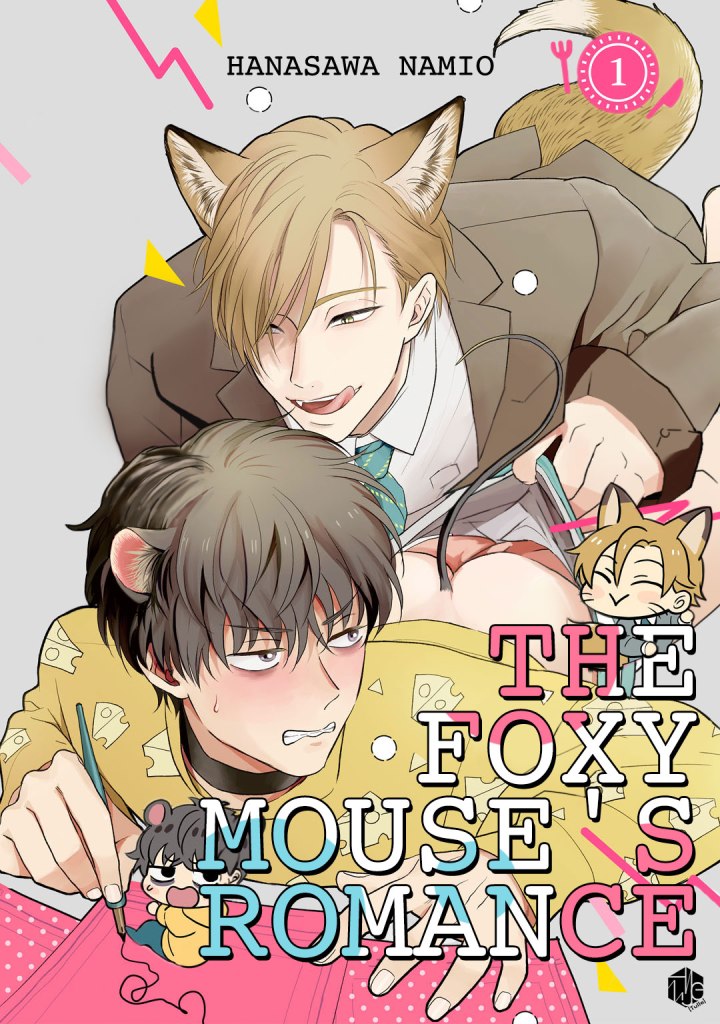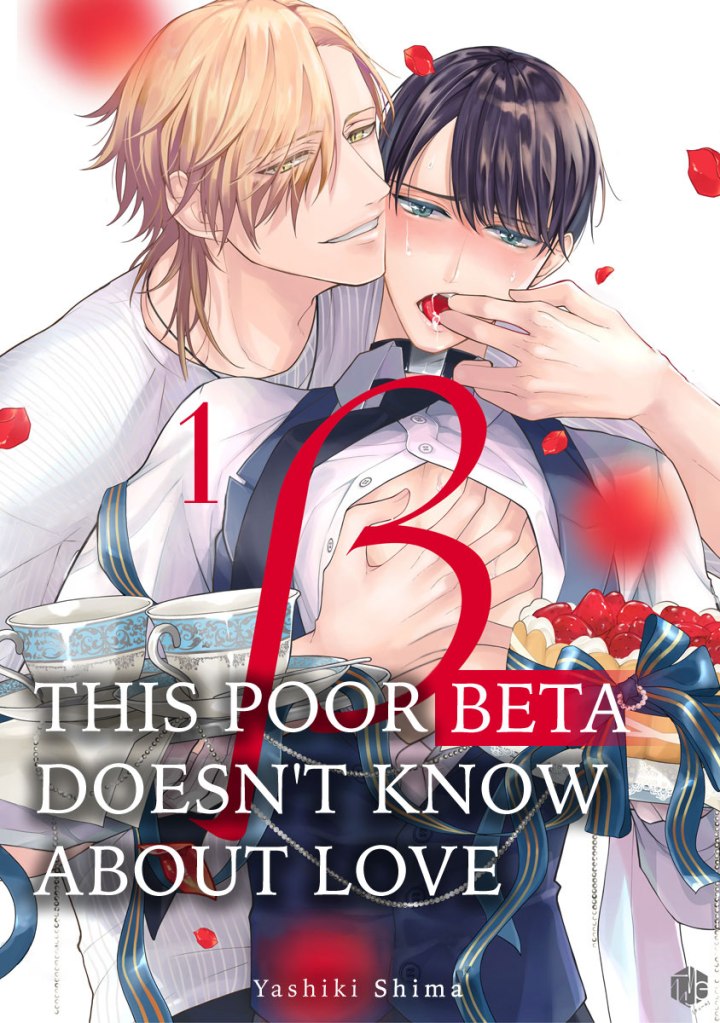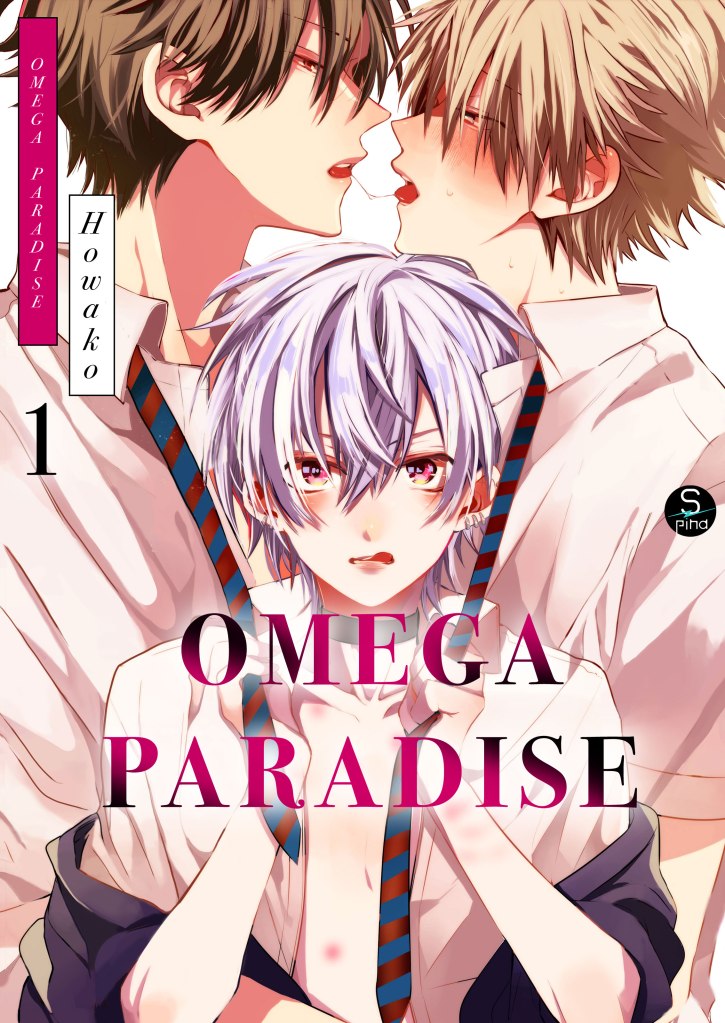Blooming cherry blossoms be damned, Japan has been in a rainy mood lately. It’s probably the kind of situation when most people would like to indulge in something uplifting, like a comedy or happy song; but, if you’re anything like me, you prefer to consume media that affirm the rainy season tenfold. That’s sometimes the appeal of sad, dark stories, after all. Which is why this humble purveyor of angst embarked on another exploration through the Renta! catalog, not to find our many cute, sweet, domestic, sexy omegaverse manga, but the stuff that shows people utterly under the thumb of a society governed by biological urges.

Which means of course, here’s a hefty content warning for the most ruthless things omegaverse might offer—if you’re looking for something to scatter the rainclouds rather than darken them, how about Sou’s April Fool’s post?
Don’t let the somewhat cutesy title fool you.
This is the manga that pretty much sparked this entire post. Mangaka Kokoro Namino was featured in one of our recent sales, through which I found this and saw the multiple reviews by conflicted reviewers. The crux of the story is the question of “what if there was a law obligating companies to hire omegas so as to even out the injustices against them”? The pessimistic answer in this case is that alphas would hire omegas just to victimize them in the worst ways imaginable. Protagonist Arata is one of their victims.
The cruelty in this world that marginalizes and treats omegas as weak is juxtaposed by alpha Touya, the owner of a cat-café-capsule-hotel kind of place. He understands his own share of responsibility and doesn’t use omegas as a scapegoat for his own “beastly” urges. Ultimately, he decides to use whatever power he has to fix the corruption within Arata’s company.
Given the limited number of chapters, the rushed resolution of the plot might make sense—more importantly, it’s a good first taste of an omegaverse society that doesn’t seem to have a single silver lining about it, save for the budding romance between the two protagonists.
This Poor Beta Doesn’t Know About Love – Yashiki Shima
I needn’t go into much detail into this one more than I already have, but maybe an omegaverse-centric look is due, as Yashiki Shima’s rigid universe of omegas treasured as mates, alphas at the top of the world, and betas floundering to find their place in the equation, is a worthy addition to the list. The plot centers around Suzuharu Seno, a beta and loyal butler to Ryousuke Isezaki, an alpha heir who loves nothing more than to mate daily with his omegas. These two had always been trapped in fruitless pining for each other, unable to be together not only because of their positions as master and butler, but also because of a beta’s and alpha’s inability to mate on the same deep level as an alpha-and-omega pair (let alone produce offspring). Suzuharu craves for this deep bond so much that he embarks on nightly hook-ups, pretending to be an omega; and even gets drugged with a heat-inducing substance. Looking back, maybe one of the reasons for the title is that being an omega equals being able to receive an alpha’s love, in Suzuharu’s mind; so, as a beta, he shuts that door for himself.
All in all, it’s rare to see an omegaverse story about the struggle of betas, and especially one crafted this well. An omegaverse world is really one where no one can be happy, seems like.
A Stray Dog’s Night – Yofune Shibue
This noir, hard-boiled detective story with a vibe straight out of Madhouse’s Wicked City is another I mentioned before, but it’s worth bringing up again, especially after the aforementioned heat-inducing drugs. Alpha cop Eric’s investigating a drug syndicate that might be tied to the death of his mother, when he falls victim to one of their concoctions, too. A beta doctor named Lean finds him and “takes care of him” in his rut state, and their fates become entwined. Both omegas and alphas are pitiful creatures in Yofune Shibue’s work, as, ultimately, either group could be taken advantage of, even by medical professionals. They writhe and suffer because of the very medicine they must rely on in order to function normally. I suppose, one of the special traits of this noir world is that it views omegaverse-related meds as drugs of the addictive, toxic kind, which fits the gritty vibe of this manga to a T.
Reunited by Chance – Sakae Hiraku
Let’s continue the discussion of medicine in a/b/o with this one. Then again, I came here for the dark omegaverse and I stayed for the dark yandere trope (and dayuuum, not just any sort of yandere, but my favorite type, ooh la la). It’s the tale of beta Eito, who can’t stop thinking about the only friend he’d ever had, Nanase, Six years since their first kiss and Nanase’s subsequent disappearance from his life, they reunite and he offers Eito a chance to partake in a clinical trial for his pharmaceutical company… a trial that will change Eito’s body and their relationship forever.
First off, one thing to remember is that every author seems to handle omegaverse in their own way, and it can sometimes be surprising. One example here is the idea that a past pairing can be undone by pairing with another omega, much unlike the harems of paired omegas seen in other manga.
Another case of unique handling is that what makes this story special is the element of “fated pairs.” Societal oppression of omegas isn’t as prevalent here as in other titles on the list; instead, this underutilized concept is the main villain. Also, the cruelty in the depiction of omegaverse here is centered on the alphas; not only on the pressure put on them to excel and be pillars of society, but also on fated pairs and their inescapability. When Nanase bumps into his fated omega, they both fall victim to the intrinsic, almost predestined urge to mate. Ultimately, the tragic emphasis is on how these human beings, despite their mental faculties, morals, etc. cannot escape their innate animalistic urges. For his part, Nanase is caught up in a maelstrom of feelings: he sees omegas as victims—he sees them as manipulative vermin—he wants to make his fated partner his, the way his primal instincts dictate—he wants to be with Eito, even though they should be incompatible.
All in all, while I’d say this is low on the scale of societal darkness, it’s very high up when it comes to the depiction of just how harmful a world governed by insurmountable biology would be, for everyone involved. As a final note, “drown to death in me” has to be one of the hottest lines I’ve ever read in a manga on Renta!🥴
Now this one gives the good ol’ omegaverse an intriguing twist; instead of a hierarchy in which omegas are the gum under peoples’ shoes, they’re instead revered as gods meant to save the world from declining birth rates. Even the frenzy that takes over alphas when they find an omega in heat is one of frenetic, cultish devotion, and it’s honestly scary.
Our protagonists are hapless beta Usui, seemingly amazing alpha Yuma, and Ichita, a strange, creepy, childish guy that looks like Nagisa from Assassination Classroom who’s hiding the fact that he’s an omega for the reasons mentioned above. It’s a trio, in which the omega is the aggressive party—it’s a flip of “omega = victim,” with omegas instead presented as a natural threat, similar to sirens luring sailors to their doom. As it turns out, society didn’t treat omegas vilely because of their physical weakness, as most a/b/o narratives claim, but because omega pheromones could turn a capable, intelligent alpha (or beta) insane and bring them—and civilization—to their knees. A Helen of Troy, in a sense. Or an enchantress, witch, temptress, anyone that has been historically subjugated because, supposedly, they’re “weak” when in reality it had always been because they were feared… Am I reaching?🤪
Nothing highlights this better than Yuma crying out that, despite alphas thinking they’re at the top, they can only think about pulling their dongs out and moving their hips like animals at the mere sight of an omega. Truly, omegas are like the sirens, monstrous creatures that seduce men to their deaths; even the ritual of neck-biting and the mindset behind it is flipped, not as omegas desiring the love and attention of alphas, but alphas desiring to be an omega’s one and only; alphas aren’t born strong for its own sake, but to protect omegas.
But, when we see Ichita’s past, we see how a world in which omegas are revered isn’t necessarily good for them; at the end of the day, any society in which a person’s worth is based on things like sex, gender or reproduction, is bound to be one hell of a shitty world.
This entire plot reads like a horror story—better yet, a story about sexual empowerment told in horror format? The saddest thing about it though is that Howako seems to have dropped the series, and we’re left at a cliffhanger without resolution.
What We Do When The Curtain Comes Down – Same Zarame
Mitsuki’s an omega hiding his secondary gender for the sake of fighting fair and square with the alphas in showbiz. While privileged enough to have alpha parents in the industry that helped him set up his career, everything changed when the Fir—when he found out his gender. Still, he’s determined not to squander his parents’ support and instead compete with the alphas while pretending to be one himself. His desperation, as well as the necessity to hide the truth at all, should be proof enough of how unfair this world is to omegas… but then Same Zarame hits us with terrorist attacks that force omegas to release pheromones in large crowds, and betas and alphas respond by blaming the victims. “Omegas should be a little more careful, you know?” Or, as we say IRL, “that skirt was too short, you know?”
Then comes his polar opposite, fellow performer and alpha Mahiro. Mahiro’s proactive, bubbly, social, decisive, everything that Mitsuki can’t be by nature but is trying to appear as, through strategy and good acting.
The narrative shows how the bodily reactions of a heat and a rut are a problem for both parties involved, with Mahiro jumping straight into the action and Mitsuki giving in to doing the horizontal tango with his rival in no time at all. This also leads to the very first time I’ve actually seen pair-bonding on the page. Waku waku. It’s abrupt and without the usual build-up, but that’s because it’s an act of desperation. If Mitsuki keeps going into heat, he won’t be able to perform, but bonding with an Alpha is supposed to somewhat mitigate those symptoms. So he impulsively decides to give his neck in marriage to his industry rival.
With both the symptoms of rut-heat and the tribulations of what happens after pair-bonding, this story adjusts points from Omega Paradise into a not-so-horror script, as we’re allowed to empathize with both parties, without viewing either of them as a “monster,” a “threat,” or an “aggressor.” That’s something our omega protagonist comes to realize too, by challenging his own prejudices about secondary gender-roles.
Mitsuki’s inspiring, but at the same time, it’s sad that he needs to push himself this hard just because of biology. All his concerns about hiding who he really is from the public and being forced to “come out” in a big press conference reminded me of when celebrity Shinjiro Atae came out as gay last year. While the a/b/o allegories often revolve around gender, I couldn’t help but think that the main conflicts of this manga concern way more than just that.
The Foxy Mouse’s Romance – HANASAWA NAMIO

What more could I say that I haven’t already? During our first Fan Mail Special, I wrote a huge diatribe on just how much I love HANASAWA NAMIO’s god-tier masterpiece. And, delving into its world-building, which is one aspect I’m obsessed over, I brought up the heavy darkness lurking under the surface of this (literally) fluffy romance. Sachio’s negative attitude is a product of his circumstances, of a social hierarchy that has him placed at the bottom of the food chain as an omega mouse. He has no other choice but to be a recluse at home, exercise constant vigilance whenever he does head out, and hang out at omega-only bars (that then turn out to be a trap); the manga even opens with news that his sister got assaulted and then fired because she got into heat in front of a customer. Secondary genders poison all meaningful relationships, as he could expect to be assaulted or eaten at any moment. And, just like in reality, this society loves to push its darkness under the rug, presenting the a/b/o triptych as a ~beautiful coexistence~, rather than a food chain governed by “survival of the fittest.”
I feel obligated to bring up Sachio’s guilt over his own body causing the alphas around him so much pain, shifting responsibility on himself. HANASAWA humanizes the tricky tightrope that alphas and omegas have to balance on, and shows how both parties are victims of their own biology—and that’s without even counting in their animal traits and predator-prey dynamics. While it is a fact that HANASAWA’s alphas reap the stereotypical benefits of being at the top of the world, I’m pretty sure that best wolf-boi Tomo never wished to assault his best friend, you know? At the same time, Ukano telling him that the onus is on him as an alpha to take pheromone blockers and even increase their strength or the dosage if need be, is a very satisfying moment of defying the self-same biology that’s at the root of the problem. It’s the conflicts underlining the duality of alpha-omega, followed by the characters’ struggles to defy those conflicts, that ultimately make a good omegaverse story.
🌧🌧🌧🌧🌧🌧🌧🌧🌧🌧🌧🌧🌧
And that’s all, folks. Sorry for introducing you, once more, to angsty things, but I strive to cater to all my fellow angst afficionados. If you’re such, please comment below with your thoughts. Or, even better, is there a BL you think should’ve been on this list and I totally missed it? Do tell☕





